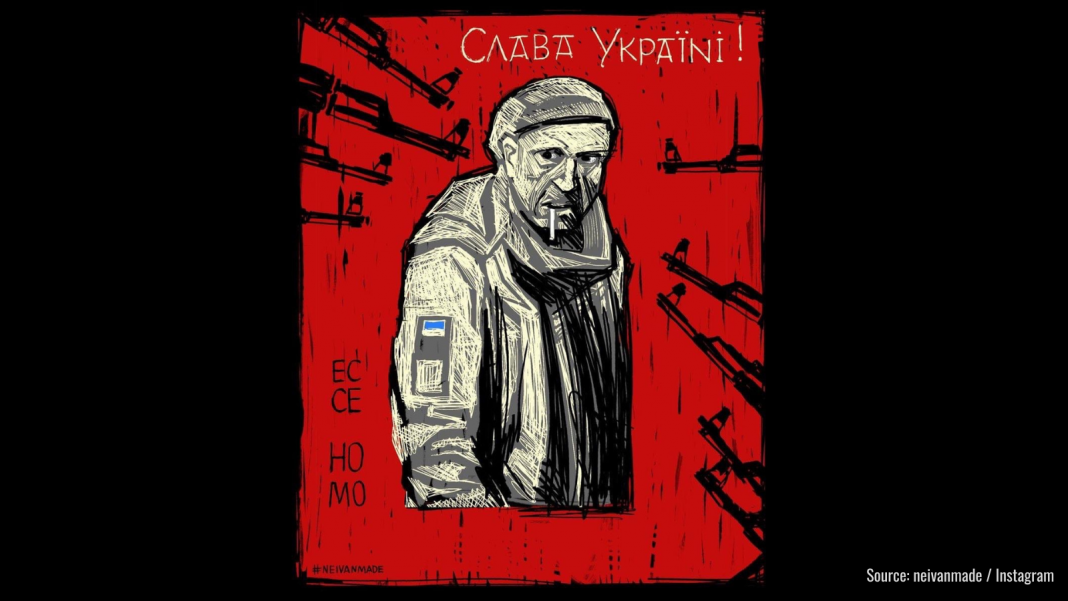A POW is executed on camera. As usual, Kremlin outlets try to confuse the world with a myriad of contradictory lies to blur who is responsible.
On March 6, a video showing the execution of a Ukrainian prisoner of war (POW) emerged on social media. The last words of the Ukrainian soldier were the call that has come to embody Ukrainian resilience – ‘Glory to Ukraine’. His execution contravened the Geneva Convention and may amount to a war crime. It also shows the impunity of Russian invaders in Ukraine.
From the video, it is not immediately clear who the fallen soldier was, but after some effort, his identity was confirmed. His name was Oleksandr Matsiyevskyy, a sniper of the 163th battalion of the 119th Separate Brigade of the Chernihiv Region territorial defence.
His death elicited condemnation and vows of retribution from top Ukrainian officials and the worldwide public. But it also gave rise to widespread Russian information manipulation, conspiracy theories, fakes, and lies. Pro-Kremlin bloggers, Russian propagandists, and others quickly undertook to whitewash his killers’ reputations.
Deploy a smokescreen
Three initial versions of this event were disseminated across different platforms. First came claims that the video was staged, then that Ukraine made the video as a provocation, and finally that the video was accurate but that the prisoner was to blame for his own execution.
The early reaction of the Russian information manipulation and disinformation ecosystem was an attempt to sow doubts among the audience about the authenticity of the video. Taking advantage of the fact that neither the place nor the date of shooting had been established yet, propagandists ‘paid attention’ to the ‘theatrical nature of the video’ and the ‘oddness’ of the behaviour of the Ukrainian serviceman, who does not become hysterical but calmly faces his enemy.
According to Ukrainian fact-checkers and the Centre for Strategic Communication and Information Security, initial claims that the video was staged did not live for very long on Telegram and were deleted by the administrator of the MIG Rossii channel almost immediately after their publication.
Russia plays dress-up
When denying the video’s authenticity or claiming provocations did not work, pro-Kremlin information manipulation and disinformation outlets spread a new narrative – the execution was real, but the POW in question was a Russian dressed in a Ukrainian uniform. This allegation was readily spread and amplified, and Kremlin-backed military correspondents and anonymous Telegram channels joined in.
Some of them even ‘found’ those who were ‘shot.’ In particular, an unnamed, mobilised medic from the Samara region of Russia and a serviceman named Denis Yakovlev from Togliatti of the same Samara region, as well as a ‘resident of Donetsk named Anatoly’.
To justify the video’s appearance for Russian audiences, pro-Kremlin Telegram channels embraced a conspiracy that it was the Office of President Zelenskyy that received ‘real benefit from the video, as it wanted to raise morale and provoke a wave of blatant nationalism and mobilisation’.
Kremlin cycle of lies spins quickly
We have seen the Kremlin cycle of lies spin many times before. Denial, deflection, distraction and discrediting the victims are the go-to tools in the Kremlin information manipulation playbook. Recall for instance the MH-17 downing, the Mariupol hospital and theatre bombings, the Bucha murders, or the Kramatorsk missile attacks, to name a few.
This incident once again demonstrated the key areas of work of Russian war propaganda: simultaneously spreading several versions to flood the information space, questioning the legitimacy of the video, disorienting the audience, and promoting the narrative that ‘everyone lies’.
The effect of such disinformation is to rationalise POW abuse during a time when the Russian army continues to commit brutal war crimes and atrocities against POWs with impunity.
Oleksandr Matsiyevskyy defended Ukraine to his last breath and his final words of defiance embody the true grit of all Ukrainians protecting their lands from the aggressor Russia. This moment, much like the unforgettable instructions a brave Ukrainian border guard gave to a Russian warship near Snake Island, will be immortalised for generations to come.





